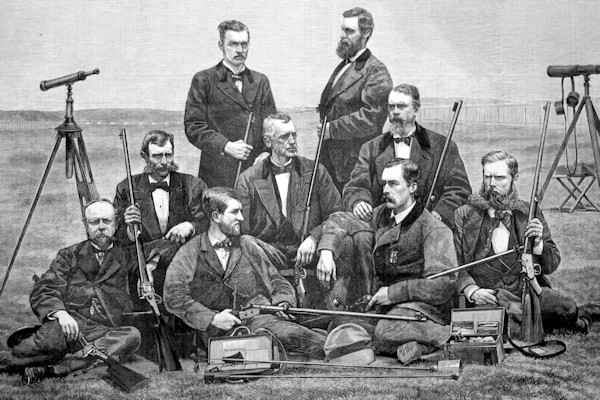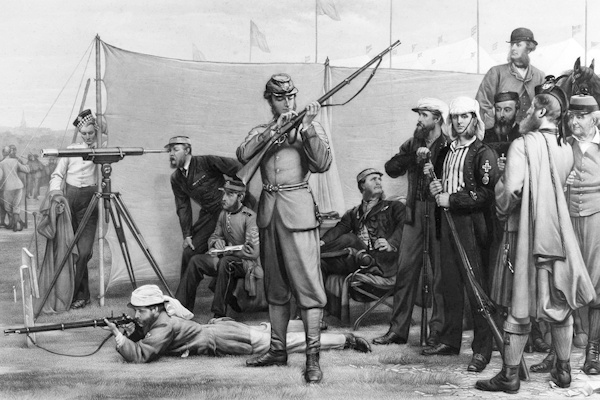In 1878 Joseph Partello made the outstanding long range score of 224 x 225, shooting at 800, 900 and 1000 yards. Partello’s score was made at practice, experimenting having decided to change the method of loading the cartridges for his Remington rifle. However, and irrespective of Partello’s obituary statement in 1934 that his record score has “existed since 1878”, it was equalled by others.
Category: 19th Century Riflemen
The 19th Century saw a huge growth in interest in rifle target shooting. Queen’s Prize winners were hailed as hero’s and thousands of spectators turned up to witness the long range international matches. Who were these riflemen that attracted such public attention….?
Browse the latest posts below, or see:
George Charles Gibbs (1859–1918)
George C. Gibbs was a gifted shot and G.T Teasdale-Bucknell in his “Experts on Guns & Shooting” (1900) observed that he “would by rifle shots be conceded the first place in the British Islands as a long range rifle shot. This position G.C. Gibbs has gained by no single feat but by constant good shooting, varied only by occasional phenomenal feats.”
Charles W. Hinman (1849-1922)
Charles Hinman was born 11 April 1849 in West Concord, Vermont. He spent his boyhood on a farm, and devoted his leisure time to trapping. As Private Charles Hinman with 1st Regiment, Massachusetts Volunteer Militia, he represented the USA in the military rifle matches of 1882 and 1883 between British Rifle Volunteers and US National Guard. By 1888 and as a Major, he was assistant inspector-general rifle practice, First Brigade.
An Illustrated Interview with Sir Henry Halford
In 1893 the influential London magazine ‘The Strand’ published an illustrated interview with Sir Henry Halford. “The Grand Old Man of Shooting,” Sir Henry Halford revelled in records almost from the very first meeting at Wimbledon in 1860, and it is a remarkable fact that amongst his prizes are those of the Albert at Wimbledon in 1862 and the same trophy at Bisley in 1893, a record lapse of thirty-one years!
Men of The Hour: Sir Henry Halford
He is standing among the British team at Creedmoor. He watches the wind, directs every shot, knows the fate of each bullet before it reaches the target. A figure tall and erect; a commanding presence. His men obey him implicitly; he is their Marlborough, their Welllington. As the books write him down, he is Sir Henry St. John Halford, Bart., of Wistow Hall, in the County of Leicestershire, Lieutenant-Colonel of the Leicestershire Rifles.
Sir Henry Halford (1828-1897)
INDEX. “The country owes to him the debt which is due to a man who made the science of rifles, as well as the practice of rifle-shooting, the main pursuit of his life, who without thought of pecuniary advantage, laboured without ceasing to discover all that could be discovered about the infantry weapon and to bring that weapon to a state of perfection.” The Times, 5 January 1897
The Woe’s of Corporal Peake
The year 1868 saw Corporal Peake of the 6th Lancashire finish 30th in the First Stage of the Queen’s Prize. This was enough to secure Peake £15 in prize money and advancement to the Second Stage where the top sixty riflemen were issued with Whitworth rifles to compete for the honour of the Queen’s Prize and its £250 prize money. The competition took place on Tuesday 21 July, during which Peake fired the then highest recorded score in the event. When news of his winning achievement spread he was carried off accompanied by a band and feted by his fellow Volunteers. The celebrations were however short lived.
Sir Henry St. John Halford
It was in connection with rifle shooting and the volunteer movement that Sir Henry was best known. At the beginning of the movement in 1860 he took command of a company of the Leicestershire volunteers. In 1862 he became colonel of the battalion. In 1868 he resigned, but resumed the office in 1878, and held it till 1891, in which year he became honorary colonel. In 1886 he received the order of C.B.

